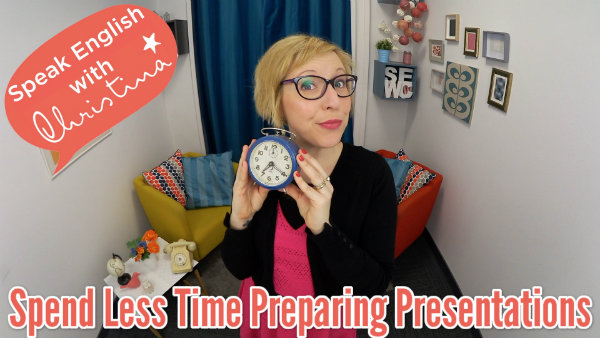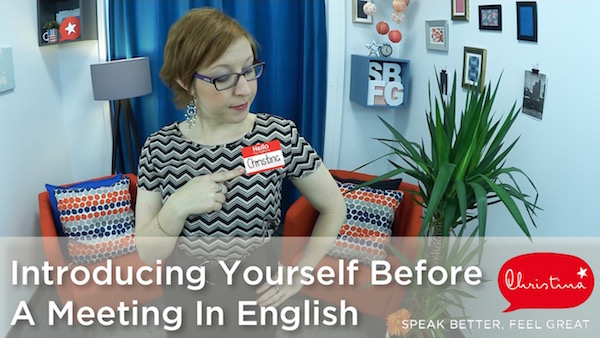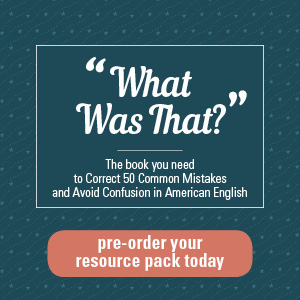
Hey there, and welcome to Speak English with Christina, where you’ll have fun becoming fluent in American English. I’m your English coach Christina and let me ask you something: When you have to do a presentation in English, maybe at a scientific congress or a business conference, how much time does it take to prepare your presentation?
Watch this episode now!
Probably more time than you’d like! Well today, you’ll learn how to save time and create a better presentation in English.
Let’s go!
In my career, I’ve presented at dozens of international conferences. I mean, isn’t it exciting to share your research and results with colleagues?
But it takes so long to prepare the presentation. For a 30 minute talk, maybe you spend weeks, or even months preparing. Plus it’s in English, so you take more time than in your native language. Let me share with you some techniques I use to save time preparing presentations.
Do your homework first
The first thing is look into the logistics. Who are you presenting to? What is the key message you want them to remember?
Why is it important to them? In fact, I would even recommend writing this at the top of your notes before you even start planning your presentation. This will guide you to help you focus, and avoid trying to include too much information, which we’re probably all guilty of (at least me…)
Start with pen & paper, not PowerPoint
There’s a quote that we attribute to Abraham Lincoln, 16th president of the United States: “Give me 6 hours to chop down a tree, and I’ll spend 4 hours sharpening the axe.”
Basically, when you have to do something, it’s worth investing the time in preparing, so the real action is easier, quicker, and more efficient. We’re not cutting down trees, but the idea still works. Don’t rush to create your PowerPoint slides.
Get a good old pen and paper (or note cards) and brainstorm the ideas you want to include in your presentation. Organize your ideas coherently. Make sure the information flows logically. Maybe even ask a colleague to look at your outline and see if it seems logical.
But spend maybe 15% of your presentation preparation time just on organizing your ideas. It’ll save you time in the next steps.
Write your script
Yes, write your script. A lot of times you might hear advice like “Don’t write your script!” or “Just write notes!” I think in my 14 years of coaching clients, 99% of them say they write scripts.
Honestly, if it helps you to write a script, do it. But notice I said write a script, not read a script. This is just part of your preparation, to make you feel confident before your presentation.
Plus, if you write a script, you can send it to a colleague or an English coach so they can help you correct any mistakes, or offer advice on clear organization.
Another advantage of writing your script?
You can see where the transitions are. When you’re doing your presentation, it’s important to use signposting language –the expressions that clearly indicate transitions. You will seem organized, confident, and your audience will follow your ideas more easily.
Practice, round 1
After you’re comfortable with your script and the organization of your ideas, practice. Read your script out loud a few times to get the feel of your presentation. Of course, the day of your presentation you won’t read your script, but for now, it’s ok. You’re preparing.
So read it out loud. Stand up and pretend you’re giving your presentation. If your ideas feel disconnected and your transitions are awkward, change them. Eliminate anything that makes your presentation hard to follow. And practice again. In fact, this practice round 1 should take about 25% of your total preparation time.
Create your slides
Finally, you can play with PowerPoint! Woohoo! Fonts, colors, slide backgrounds… Sorry, I get excited about creating presentations sometimes.
But now that you’re sure of the message, ideas, and structure of your talk, it’s time to create your slides. Notice that creating slides is one of the last steps. Because you’re pretty sure of what you’re going to say now, you don’t waste any time creating slides that you don’t need.
And here’s a tip to make your transitions smooth. Create transition slides!
For example, put in big print the exact transition phrase you’ll say on one slide, and on the next slide, the main subject of the next part of your talk. It’ll look like this:

“Now, let’s move on to…” – “The difficulties scientists have to present in in English”
It adds clear structure for your audience, it adds a bit of suspense as you transition, and for you, you’re sure to get the phrase right! So fire up PowerPoint and let’s make some slides!
Practice, round 2
Now that you have your slides, it’s time to practice again. Several times, in fact. And this time, without your script. The idea here is to progressively reduce your complete script to just enough notes to guide you in your presentation.
You can add notes in the “presenter notes” part of powerpoint, or use index cards. Just remember to put numbers on them! This way, if you drop your cards, it’s easy to put them in the correct order!
This is your final practice round before your talk. And by round, I mean, it might be several days of practicing, a few times a day.
Like practice round 1, this 2nd practice round should also represent about 25% of your entire preparation time.
So yes, that means that 50% of your entire preparation time is dedicated to practicing.
Because what’s the best way to be sure you sound good speaking English? Practice, practice, practice!
Now, what about you?
How often do you give presentations in English?
Tell us about a presentation you did in the past in English.
It will be interesting to see what you’re an expert in! Share it with us!
And to better understand Americans’ accent when they ask questions at the end of your presentation, get my American Accent Survival Kit.
You’ll start to better understand Americans when they speak fast, thanks to a full comprehension and pronunciation lesson, plus a worksheet to test your comprehension. Just click here to get it!
Thanks for watching Speak English with Christina, and I’ll see you next time!
More English lessons...
Click the image to see the lesson








Hi Christina
Thanks for this very interesting video and your useful tips. I do not give presentations every day but often enough to be quite experienced. However, I never feel fully confident while presenting. I sometimes write scripts myself but thought that it might have restrained my spontaneity. You confirm my assumption that a good presentation is related to a lot of work. When I watch your videos I think,… wow! I would like to be as confident, to be able to catch the attention of my audience like this. I should practice and prepare more and schedule more preparation time.
The language is a real issue. Working with people from various countries, I prepare most of the time in English. However, if by chance my audience is entirely German speaking, I’ll have to switch to German and this is not an easy exercise even though my German is more fluent than my English. I get nervous thinking that I might not find the right terms. I haven’t presented in French for ages, even though this is my native language and I am practicing it regularly, I am not sure to be able to switch so easily to French.
Hi Christine,
Thanks so much for sharing your presentation practices with us, and for your feelings about giving presentations. I’m glad you found the tips helpful. You’re right, becoming confident with presentations is a combination of work & preparation + practice. But not just practicing a specific presentation, but practicing doing many different presentations. This way, you get used to presenting and you know what you need to do to feel confident, and you know what to do when something goes unexpectedly (like your audience being all German, and suddenly, you have to switch to German…or French!) I would love to be able to give a presentation in German 😉
I did just 2 apresentations, it was the greatest challeng of my life, so far!!! But I would like to be ready to a apresention in scientist meeting in a close future!
Hi Célia, Way to go! I’m so proud of you for doing those 2 presentations! How did it go?
And for your future meeting for a scientific meeting, what do you have to present? What do you need to do to prepare your presentation? What do you have questions or doubts about?
Hi, Chistina.
I use presentations during my lessons and I watch a lot of students’ presentations. Last time I did presentation about the sights of London. I had spent about 2 hours to do it (to find texts and to choose simple sentences in order my students could understand them, to find pictures). But after my presentation my students did their presentations which were difficult to understand, as they didn’t want to spend time choosing sipmle sentences. I think it’s important to teach them how to do presentations, to write an instruction how to do them.
Thank you for your tips and for your short videos.
I cannot aford to buy any of your courses, so I can use only free of charge lessons.
I’m looking forward to your new lessons.
Best wishes,
Natalia
Hi Natalia,
Thanks so much for sharing your story. Are you an English teacher too?
You’re right, it takes time to prepare a good presentation, and unfortunately, many students just see presentations as another school assignment to complete, on top of all the other assignments they have for other classes.
Also, from my own experience teaching in schools, I think a lot of students have difficulties seeing the immediate benefit of learning to do a presentation in English (since the only place they often have to do them is in school. It’s not like in companies, where good presentations can have real impact on your results, job, or salary). But you’re right, it’s important for them to learn to do good presentations, or at least to get their feet wet, as we say.
Then when they have a high-stakes presentation later in life, they’ll probably spend more time and effort in preparing. I hope…